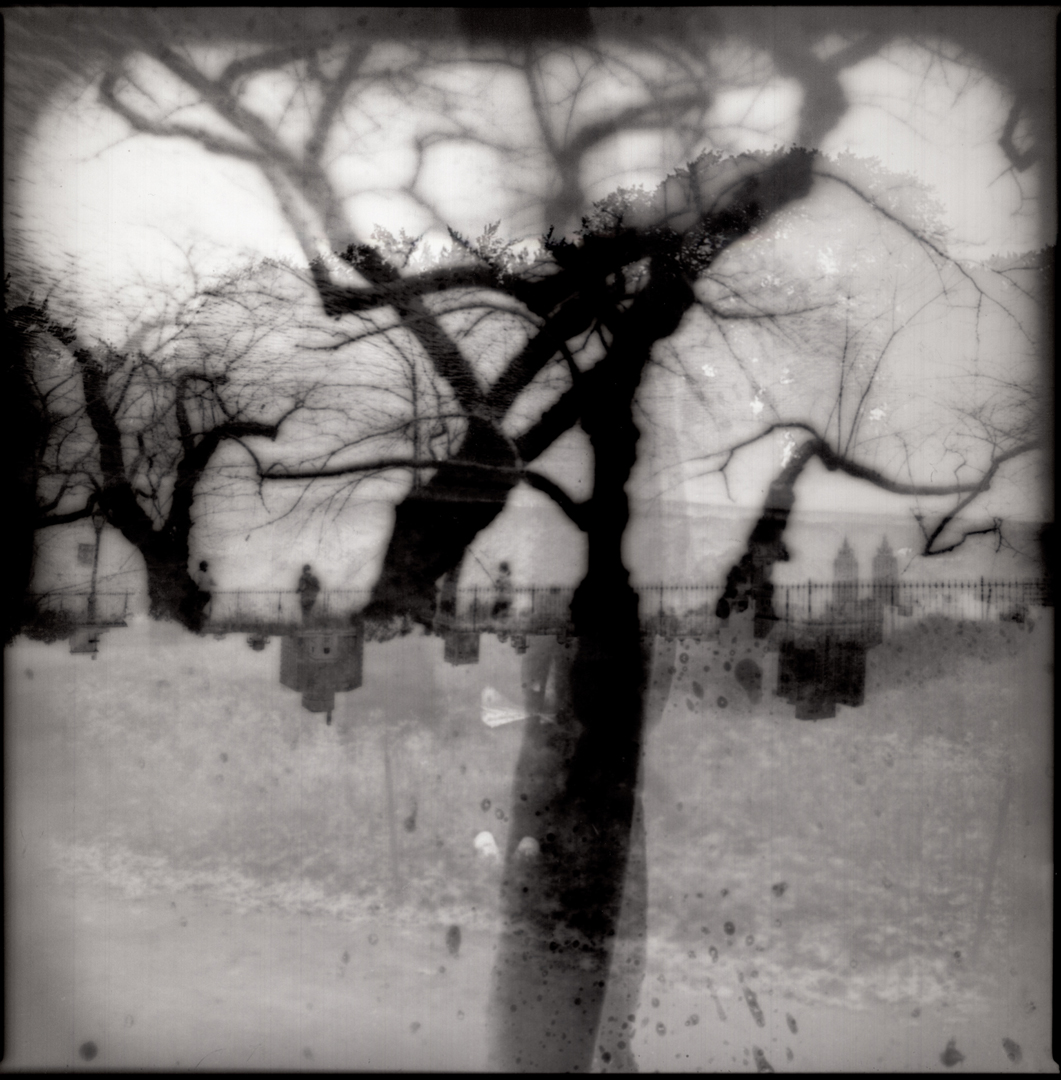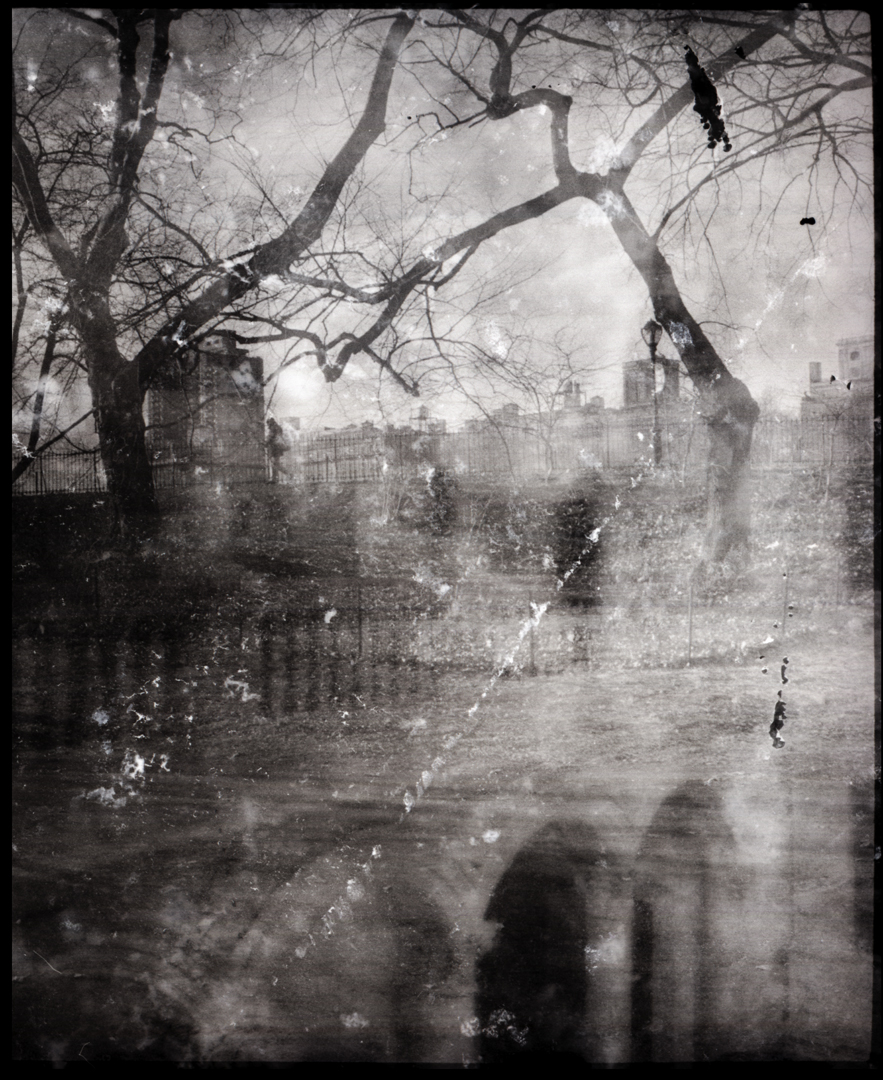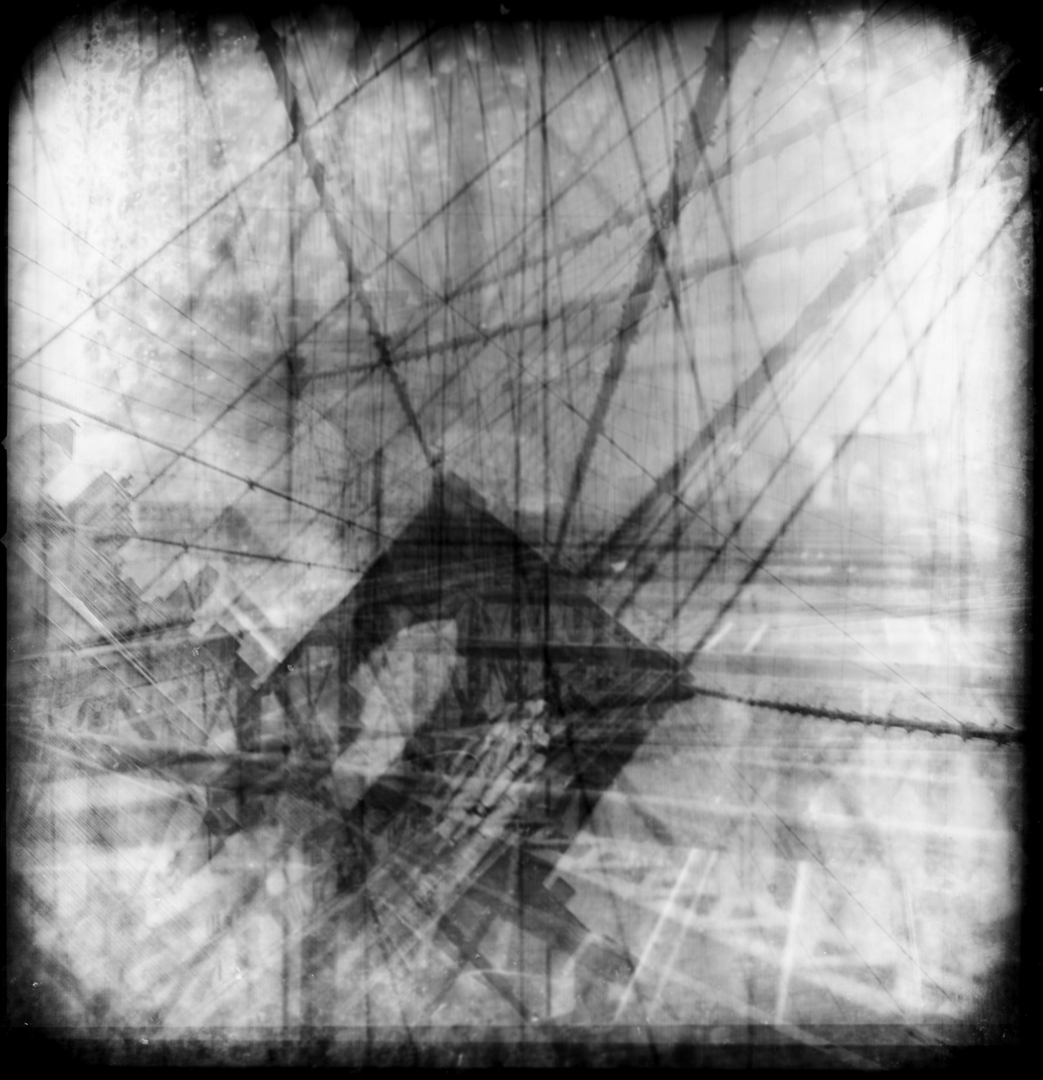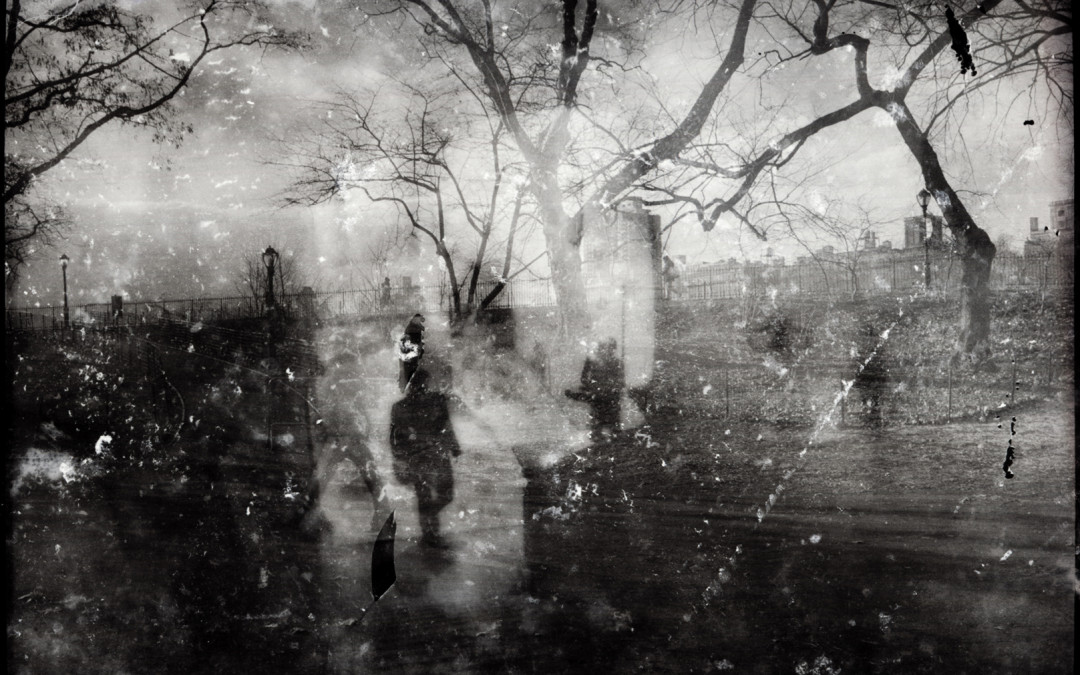© Cynthia Karalla
Central Park, NYC
Experimental Photography:
aaaa
Experiencing a State of Mind
by Richard Rabel
Experimental contemporary photographer Cynthia Karalla, influenced by Eugene Atget (1857-1927) and his photos of the trees around Versailles and Saint Cloud, like Atget, pays homage to the tree and its heroic position living within a man-made world. But she is also inspired by the moody renderings of “Gotham” by Hugh Ferriss (1889-1962) that reveal life in a Gothic soul-less city. Experimental photography can be, at its most basic, about grabbing a camera and experimenting by shooting everything you see. And while this is close to what it means, if we think of it in that way, we miss a deeper meaning.
You see, experimental photography is not so much about what or how you frame the subject or what camera and lens you use, but it’s more about the state of mind of the photographer. And it’s not about whether the artist is happy or sad; mad or excited. It’s about first, unedited photo shooting – no notion of what you want to achieve, no filters, no preconceptions – and secondly, about evaluating the results (not the other way around). “There are no failures” in experimental photography Cynthia told me one time, “… you learn along the way and there’s nothing to lose. Finding something is the reward and there’s never any loss”.
Case in point, after six years of photographing the same tree in the park, it was only recently that she got something she could actually embrace. It wasn’t the tree that changed, but it was everything around it (including her) that finally let her see and represent the tree in its proper relation to its surroundings. Patience really is a virtue!

***

Central Park, NYC

Brooklyn Bridge, NYC
The Process
by Cynthia Karalla
Shooting, in the awareness of time, I chase the light, shadows and details. Always with a minimum of 10 rolls in my bag.
Developing the film is by pushing, pulling, always testing the limits. These last 2 years I have been processing through my homemade stand development recipe, sometimes the film sits for 3 hours in the mix.
The negative is my beginning, to bleach, bend, cut, scrap, throw the negatives in a drawer or leave them out on any dusty surface, anything to let it collect life.
Rebuilding the image is where I am always unaware of time. I start with the most hopeless images, because there is nothing to lose. Hours mesh into days, there is an alchemy of magic that comes into play. The only thing I am aware of is the afterwards, I find it impossible to walk among the people on the street or even speak to another living soul.
Editing the aftermath, being a one person operation, I restart the play again with my cameras, to create a distance and procrastinate from the process of editing. After a 5 to 6 month period I can return to the previous project with fresh eyes, and edit the images, this process helps me to see what I could not see before.
My process was once a passion, now it is my addiction.
[layerslider id=”22″]
All photos by Cynthia Karalla, used with permission.
-30-

Cynthia’s images begin as photographs, but then somehow organically transform themselves into a more personal reality. It matters not what process she uses, the net result is usually greater–and more ethereal–than the earth, trees and sky she started with.
Thank you Will 😉
incredible photography and museum quality! I’m in a MoMA show now so you know my quality taste!
These are amazing, Cynthia has the extra-ordinary ability to capture raw beauty. The pictures are like fairy tales to me. They make me want to find out what happens next in the following chapter.
Thank you Marjella…. 😉
Enigmatic pictures of a contrarian photographer,
showing entropy & decay, but also passion & poetry.
Central park bleached reminds me of earth artist Robert Smithson’s fascination
for the ‘Jurassic’ aspects of this time-capsule in the heart of NYC…
Johan, you were there for the magic… 😉
The eerie light and the contrasts draw one into the images, into a ghostly timelessness… Absolutely stunning.
Splendid haunting work by Cynthia Karalla!!!
Karalla is a photographic genius. Her dream-like pieces transport the viewer to another world and reality altogether.
these are absolutely gorgeous!
I’m a big fan of Cynthia’s work, as an observer it’s beautiful, and as an artist it’s inspirational. Each image in this series is like a story told in a single moment – as if a long forgotten memory leapt into the forefront of your mind. There is emotion and sensation in every piece, and to view each photo is to experience not only the space and time captured within, but also the effort put forth to create them.
Poetic beauty!
Great image!
Got the feeling I was watching a short movie, all those distinct images together as one made me wander.
Cynthia’s work is never tired, routine or ordinary and this article makes an honest effort to capture Cynthia’s process. As someone who has the pleasure of knowing Cynthia on a more personal and communicative level, I can tell you that Cynthia’s work are a product of her personal energy and unique perspective and her latest project is no exception. By injecting her own style and attention to detail Cynthia has managed to construct an ethereal aesthetic that seamlessly blends both classic and modern styles.
Amazing images!
Magic pictures.
They are not so much about letting you see a spot as you never saw it before. They are about letting your mind create a world out of that spot, and recreate it every time you look at the picture again.
Francesca
Remarkable work by a woman with obvious incredible sensibilities.
Where can we find her work?
http://www.karalla.com
I love these. So surreal.
Yes, I see it too.
Timeless pictures! I’m a big fan.
Ms. Karalla’s disquieting images are not so much scary as scarifying. Half found, half birthed—they mutter at one, and *will not* be still. Her’s is a mind I wish I knew.
Wow… I’ve never seen anything like these… Incredible. So ethereal. I wish this artist the best !
Thank you Karalla! Great work of a great artist.
haunting, spell binding and unsettling, these are among the artist’s finest works!
the collecting life became beautiful and capturing the magic.
Passion and patience.
Gratulation
These beautiful photographs assure me we are on the cusp of an analog resurgence.
When each image contains such hidden depth and deeper meaning it’s not surprising that Cynthia’s work leaves so many of us so captivated. She’s a true talent!
Thank you Sadia ?
I just have one description for Cynthia´s work: Marvelous!!! Every single shot she takes contain a lot of passion, amazing ideas and a single objetive: offer a great work and inspire all kind of emotions. Her passion is remarkable.
Luckily had the chance to see her “in action” during her shooting sessions and post work and definetely the result of every picture have something a ethereal, poetic and also magical.
For me, her technique, passion and constant evolution are her best qualities like artist. Keep following her work. Congratulation for your work Cynthia and wish you the best.
Like a modern symphonic work, Cynthia Karalla’s experimental photography transports the audience over time. Like a great public speaker, Karalla’s work provides an urgently needed “emotional commentary”.
just beautiful!
These images are only ostensibly of our world. They are, rather, of Cynthia’s soul.
And they capture a beautiful, mysterious place.
In the strictest sense of phrase, Cynthia Karalla is an artist’s artist: a dreamer who lingers in the presence of beauty.
Bravo Cynthia! Great to see you still out there pushing the boundaries of the photographic medium
fotografie bellissime in cui riecheggiano atmosfere gotiche. la tecnica mi riporta alla mente scenari in cui vedrei passeggiare bela lugosi. cyn è sempre bravissima nel partire dalla tradizione e renderal sempre nuova ed interessante grazie alla sua enorme dote sperimentale.
Great work Cynthia!
These images are haunting and beautiful… like the city they celebrate, they combine time and perspective to capture a place that we think we know well, but realize that there is much more to be discovered. Cynthia’s use of film, which many have eschewed, reminds of us why the medium is so interesting, flexible and, well, human. Brava.
These compositions are mesmerizing. I can hear the soundtrack in my mind as I journey through their individual stories. Having followed Karalla’s work for over a decade, I’m increasingly impressed with how she’s been able to create an identity in her work that can is immediately identifiable as her own. The bleached series to me is poetic, haunting, and maddening in its silence, yet is symphonic, elegant and delicate. Brava, Cynthia.
Karalla takes chances with her work, an artist’s moral obligation when one wants to move forward, and she does so with such poetry. Bravo!
Revisiting Cynthia’s art is to remind oneself of the extraordinary, exquisitely atmospheric nature of her work. Seemingly mundane subjects are transformed into ghostly, multi-layered images which both challenge and reward the observer and render conventional photographs rather banal.
I love love love this whole series, especially the Brooklyn bridge photo. The series creates a sense of anticipation or apprehension – like something is about to happen, or should happen. The perspective of foreground and background are somehow amplified and it feels like you’re seeing it through your own eyes but in a dreamlike state. Beatiful, haunting, surreal & real.
Somehow times passes in these works – each image is ghost-like and feels like it’s been around forever, or rather each image seems located in time, as if you’re seeing the beginning, middle and end of its existence, or its MEANING in time. Really beautiful, unusual work.
Amazing pictures created by an amazing artist! I am glad to be inspired by Cynthia! Great work! See you soon
Woww, it’s so amazing….it’s like a dream!!!!!Complimenti all’artista
Absolutely the best photography of Trees and ErLaMo Culture (Early Late Modernist Industrialized Civilization) that exists in the World today!
i AM ALWAYS TOUCHED BY CINTHIA’ S PHOTOGRAPHS, THEY ARE SOULFUL AND MOODY AND THEY JUST GET RIGHT THROUGH YOU, TOTALLY A FAN OF HER!
congratulations for your work. they are different from your work that I knew, but they are very poetic!
Cynthia,
I find your work to be a very personal and visually powerful expression of your psychology. The evocative is manifested in your ability to see and articulate. I love what you are doing and will be excited to see your work further evolve.
are these images that have been wrecked by weather or images of weaher’s wreckage? Terrifically confusing and aesthetically challenging and slices of life in all its guts and glory. Go Karalla GOGH!
Waoh! Fantastic Cynthia: it’s like a trip in the past but with a superb modern flavour! 🙂 Hugs, Angela
Amazing images! So beautiful!
Gorgeous photographs Cynthia. You capture the heart and soul of NY.
I love Cynthia’s pictures. It always feels like you are on a trip to an eerie, distant land filled with white emotions…
great addiction, you can appreciate her soul inside the picture!
Having spent time in Central Park (like most New Yorkers) it is a very special place for me. These photographs are like looking at a dream sequence or a memory that belongs to someone else. Yet, I can’t help but feel as if I’ve been in that moment myself. What is unseen is as prominent as what is seen, the process is what brings so much more to the viewer’s experience. Just beautiful, beautiful work.
Cynthia’s work explores the space between reality and time in such a beautiful way.
LOVE love this work. I often re-post Cynthia’s images on FB and always get praise, nice to see it here BOW WOW!
Great article!!! I really love your work!!
The longer looked at the photos, the more goosebumps I got! Every photo is hauntingly beautiful!
Cynthia’s works of art are captivating. They transport one from across the world into the present, enabling those of us with a passion for NYC to relive our memories of this incredible city. The landscape pictures evoke feelings of being present and one can almost smell and breath in the atmosphere. An incredibly gifted artist. Keep those precious moments of reliving our happy memories through your art coming Cynthia. Thank you.
Landscapes of the Soul. Beautiful.
An amazing and poetic visionary!
This collection of images is beautiful, mesmerizing and haunting. And to be perfectly honest they make me feel a little uneasy like I’m in a dream or a spirit glimpsing a world left behind. As an artist you’ve definitely created a body of work that elicits an emotional reaction.
Stunning, stunning work.
I have seen various work from her. It’s amazing what she can do! Also with this work…its stunning!
These beautiful, ghostly images create as true a portrait of New York as any I’ve ever seen.
Simply beautiful. I can really see and feel the depth of the process used to create these wonderful interpretations… Funny, the emotional reaction they elicit in me is that of calm…plus a curious desire to see what Cynthia would do with some of my personal landmarks!
Truly unique and magic images. Love them! Great work Cynthia.
Amazing photos! I have been a huge fan of Cynthia Karalla for some time now, and I am pleased to see that she is getting a feature of this sort. You can see that she puts a tremendous amount of work into these.
These photographs extract certain timeless depth that seem to mirror how Native American cosmology perceives what is embedded in and is manifested by objects, especially trees, linking them directly to magic, mystery and spiritual world.
There is a oneiric quality about Cynthia´s photos. Original and creative. Extraordinary beauty.